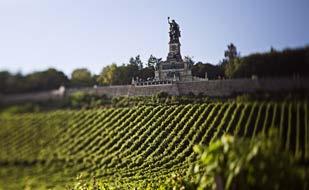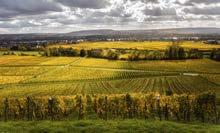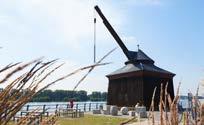
7 minute read
Rheingau
SHEER “JOIE DE VIVRE”

Advertisement
It’s thanks to a quirk of nature that the Rhine interrupts its northerly course near Wiesbaden, where it makes a right-angle bend and flows west for 30 km (19 miles) toward Rüdesheim, where it resumes its original path. The river was forced to yield to the foothills of the Taunus Hills, resulting in the creation of a narrow strip of land that straddles the 50th degree of latitude on the right bank of the river – the Rheingau. The wine region extends from Flörsheim-Wicker in the east to Lorchhausen in the west.
This pretty little area is planted with 3,200 ha (7,900 acres) of vines. It is known first and foremost as the home of riesling, the grape that accounts for 80% of the region’s vineyard area. The other important variety is Spätburgunder (Pinot Noir), long associated with the village of Assmannshausen. riesling thrives on the region’s dry, stony, south-facing slopes. It can withstand cold winter days, and develops fine, fruity acidity and aromas during the long ripening season. The monks at Johannisberg monastery had already discovered the benefits of a late harvest in 1775, and to this day, rheingau riesling Spätlese wines number among the region’s flagship wines. rheingau wine-growers are always searching for ambitious challenges. Their latest joint effort to produce something exceptional resulted in the creation of a premium-quality category of wines labeled “estes Gewächs” (literally, first growth). The grapes are sourced from classified top sites (or parcels thereof) and subject to very stringent quality criteria, from the vine to the bottle.
The rheingau is a very popular tourist destination, where ancient monasteries and castles are nestled

within the vine-clad landscape. The rheingau riesling route is a 120-km (75-mile) driving route that takes in the region’s picturesque wine villages.
en route there are dozens of wine restaurants and pubs where visitors can stop in to sample the local wine, and cultural-historical sights are around every corner. The Niederwald monument overlooking rüdesheim, the terrace at Schloss Johannisberg, or the heights of Hallgarten are all vantage points that afford fabulous views. The cultural wine center of the rheingau is the former Cistercian monastery Kloster eberbach, one of the best preserved monastery complexes of Germany. Johannisberg is not only known for its palace, built on the grounds of a former Benedictine monastery, but as a site that stamped the history of German viticulture – the birthplace of Spätlese – and late-harvested wines, in general. Last but not least, the rheingau is home to one of Germany’s oldest and most respected research and teaching institutes for wine (in Geisenheim). Its endeavors have been an impetus for quality improvements since its founding in 1872.
RHEINGAU – AT A GLANCE
Geographical location: Begins near confluence of the Main river with the rhine, southeast of wiesbaden, and extends on the right bank of the rhine to Lorchhausen, north of rüdesheim · Climate: Protected by the Taunus Hills; mild winters and warm summers; average temperature of 10.6°C (51.1°F) · Soils: heavy tertiary marl soils; slate, quartzite, gravel and sandstone; loam; deep, usually chalky soils of sandy loess or loess; medium-deep and deep phyllite slate · Size: ca. 3,200 ha (7,900 acres) · Grape varieties: riesling, Spätburgunder (Pinot Noir)
rheingau wine estates and restaurateurs stage upscale wine and food events year-round: rheingauer Gourmet Festival in March, Schlemmerwochen (gourmet weeks) in late April/early May, rheingau Musik Festival throughout the summer, and the Glorious rheingau days in November. The traditional wine auctions at Kloster ebebach (spring and autumn) offer a unique tasting experience.
Information: Rheingauer Weinwerbung GmbH Chauvignystr. 12–16 65366 Geisenheim Tel. +49 (0)6722 93770-0 Fax +49 (0)6722 93770-29 wein@kulturland-rheingau.de www.kulturland-rheingau.de
Rheingau: Landmarks of German Wine Culture

KLOSTER EBERBACH, RHEINGAU
“The door stands open, but the heart even more so!” Such was the traditional greeting of the Cistercians who lived at Eberbach Monastery near Eltville on Rhine. The former cloister now welcomes visitors in a different context: as a highly renowned winegrowing estate. Its fine wines serve as “liquid ambassadors” for this special place and the winegrowing tradition of the Rheingau.
In the Beginning There was Pinot... when the Cistercians first settled in eberbach Monastery 900 years ago, they carried with them vines from their Burgundy homeland. The mild rheingau climate suited the variety, and soon the resulting Burgundian-style wines developed into a major export product. when the monastery was dissolved in 1803, the winegrowing estate transferred over to state possession. As the domäne Steinberg it is now part of the Hessian State wineries.
The historical Steinberg vineyard, enclosed within 18th century stone walls, can be found directly in front of the monastery's gates. At 34 hectares (84 acres), it is the largest site in the rheingau and is currently planted exclusively with riesling. The Steinberg cellar, one of europe's most cutting-edge wine production facilities, opened its doors in 2008. The Hessian State wineries currently manage 220 hectares (544 acres) of vineyards, including 161 hectares (400 acres) of riesling, 32 hectares (80 acres) of Spätburgunder (Pinot Noir), 7 hectares (17 acres) of weißburgunder (Pinot Blanc) and 3 hectares (7 acres) of Grauburgunder (Pinot Gris).
Hessische Staatsweingüter, Kloster Eberbach eltville im rheingau Tel. +49 (0)6723 60460 www.klostereberbach.de

SCHLOSS JOHANNISBERG, OR: THE DIVINE ORIGINS OF SPÄTLESE, RHEINGAU
“I espied the light of the world on the banks of that lively flow, where folly grows on green hills, to be plucked, pressed, poured into barrels and sold abroad in autumn,” Heinrich Heine wrote in his travelogues. “Mon dieu! If I were so strong in faith that I could move mountains – the Johannisberg would be precisely the peak that I would have sent after me wherever I went.”
Good Things Come to Those who Wait Heine's enthusiasm likely derives from the fact that Spätlese (late harvest) wine was invented – albeit unintentionally – here on the Johannisberg. In the mid-18th century the Johannisberg and its hillside vineyards were in the possession of the Prince-Abbot of Fulda, meaning the harvest could not proceed without his written permission. one year, in 1775, the vintners waited impatiently for his approval, even as the grapes hung ripe on the Johannisberg. By the time the prince-abbot's blessing arrived two weeks later, the berries had shriveled on the vines and in some cases were covered with mold. In desperation, the manager of the episcopal winery ordered the grapes to be pressed anyway – and the cellar master was soon shocked to find that the “rotten” harvest had actually produced a wine of unsurpassed quality. Since then, delayed harvest on the Johannisberg is a feature not a flaw, and the late harvest of grapes with 'noble rot' that started in the rheingau has won the hearts and glasses of wine growers and wine aficionados the world over.
Fürst von Metternich Winneburg’sche Domäne, Schloss Johannisberg Geisenheim Tel. +49 (0)6722 70090 www.schloss-johannisberg.de
OESTRICH-WINKEL, RHEINGAU
Only four cities in the Rheingau were ever awarded the privilege of operating a loading crane. One of these was Oestrich. The historic crane on the banks of the Rhine is more than just a symbol of the town – it also expresses the importance of Rheingau wine for the marketplace. The Oestrich crane was primarily used to load wine barrels onto boats shipping along the Rhine. In 1780 that totaled over 500,000 liters of wine in 420 barrels (each 1200 liters).
Fully Loaded The crane was built in 1745 on a quay wall on the banks of the rhine. Up until the construction of Bundesstraße (Federal Highway) 42 it had two sides

directly on the water. As a land-based crane, it was considered more secure and easier to maintain than floating cranes, popular at that time but more heavily impacted by the constant waves on the river. The square-shaped, treadmill-powered tower crane is set atop a sandstone base that itself rests on foundations driven 1.5 meters (5 ft) deep. A 9-meter (30 ft) crane boom extends from its slate-tiled roof. The interior of the crane house contains two monumental wooden wheels turned by crane boys who strapped themselves in and turned the crane winch manually. Two such crane boys were generally needed for each treadmill, with more in the wings for especially heavy loads. The oestrich crane could handle loads of up to 2.5 tons. It remained in operation until 1926, the last loading crane of its type in Germany, but remained fully functional to the end. Today it is the sole remaining loading crane on the right bank of the rhine.
Tourist-Information oestrich-winkel, Hermannstraße 6 Tel. +49 (0)6723 6012806 www.oestrich-winkel.de










